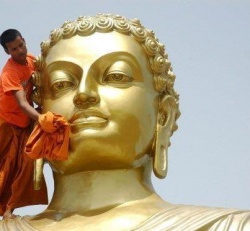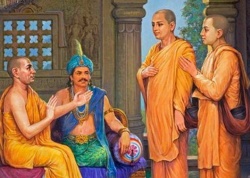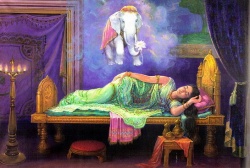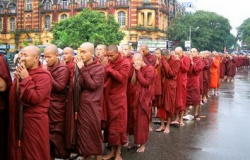Early Yogācāra and its Relationship with the Madhyamaka School
By Richard King
I.Introduction
D. T. Suzuki noted as early as 1928 that
Most Buddhist scholars are often too ready to make a sharp distinction between the Mādhyamika and the Yogācāra, taking the one as exclusively advocating the theory of emptiness (śūnyatā) while the other is bent single-mindedly on an idealistic interpretation of the universe. They thus further assume that the idea of emptiness is not at all traceable in the Yogācāra and that idealism is absent in the Mādhyamika. This is not exact as a historical fact.(1)
As the second important philosophical school to develop in Indian Mahāyāna Buddhism, the Yogācāra school seems to have developed the distinctive features of its philosophy from a comprehensive analysis of meditative experience (hence the name 'Yogācāra'—the "practice of yoga"). In discussing the philosophical perspective of the Asaṅga-Vasubandhu school of thought, preference will be given to the doctrinally neutral term 'Yogācāra' in opposition to the epithets 'Vijñaptimātratā' and Vijñānavāda', which are frequently used to designate this school. This reflects the wider denotation of 'Yogācāra' and its relative independence from certain specific theoretical positions. This is particularly important when dealing with the early stages of a school's philosophical development. It should be noted, however, that the term 'Vij~aptimātratā' (Cognitive-Representation-Only) is preferable to 'Vijñānavāda' (the doctrine that "consciousness [alone] exists"), when referring to the literature of the early Yogācāra, since the former term (unlike Vijñānavāda) is at least used by Maitreyānātha, Asaṅga, and Vasubandhu. In fact, since the early Yogācārins did not accept the ultimate reality of subjective consciousness (vijñāna) , the term 'Vijñānavāda' is particularly inaccurate. This epithet, nevertheless, may be applicable to the later doctrinal position of the Dharmapālan lineage of the Yogācāra, which, according to Yoshifumi Ueda, upheld the view that the external world was merely a transformation of an ultimately real subjective consciousness (vñanapari.nāma).(2) As we shall see, however, even the term 'Vijñaptimātratā' may prove Asaṅga-Vasubandhu school of thought. inappropriate as a final designation of the
The wide scope of the term 'Yogācāra' is clear from the fact that it was originally used in India as a general term for the "practice of yoga" (yoga-acāra). Thus, the colophon to the Four Hundred Verses (Catuḥśataka) of the Mādhyamika Āryadeva describes the text as 'bodhisattva- yogācāra.' The term seems to have derived its later doctrinal and scholastic specificity from the title of Asanga's major work, the voluminous
p. 660
Stages in the Path of Yoga (Yogācārabhūmi). This work, however, far from being a sectarian exposition of Yogācāra ideas, is a large-scale compendium of the stages of the Buddhist path, of which only a small part is devoted to the specific interests of the Yogācāra school. This is a feature of much of Asaṅga's literary output, the other great example being his Compendium of the Mahāyāna (Mahāyānasaṃgrāha). Although the works of Asaṅga and Vasubandhu do show a marked development of ideas in the delineation and analysis of the yogic path when compared to their Mādhyamika predecessors. this should not necessarily be seen as characteristic of an antithetical attitude toward the earlier exposition of Mahāyāna philosophy. The specific attribution of the terms 'Yogācāra', 'Vijñaptimātratā', or 'Vijñānavada' to the thought of Asaṅga and Vasubandhu should always be used with extreme caution, lest one read back the scholastic controversies of later times into the early stages of 'Yogācāra' thought.
It is often stated that the first evidence of Yogācāra ideas can be found in the Saṃdhinirmocana-sūtra. This text is of great historical interest, not only because it is a 'crystallization' of a particularly early phase in the development of the Yogācāra (in chapters four and eight), but also because of its description of the 'three turnings of the wheel of Dharma' (dharma-cākra). Thus, the sūtra declares that
By the first Turning of the Wheel of Doctrine, (Buddha) taught the doctrine of the āryasatya and on its basis the astivāda of the Abhidharma has been developed. This astivāda was negated by the Prajñāpāramitā and there has been established the śūnyavāda of the Mahāyāna. The amalgamation of both asti and śūnyavāda is now done in the Saṃdhinirmocana, and it is the last and the highest turning of the Wheel of Doctrine.... The ultimate doctrine of the Mahāyāna is, no doubt, taught in the Prajñāpāramitā, but its way of exposition is 'with an esoteric meaning', or 'with a hidden intention'.(3)
The Saṃdhinirmocana-sūtra, then, does not see itself in terms of the establishment of a rival school to the "śūnyavādins"; rather it sees itself as the text which 'explicates' the true meaning of emptiness. Thus, VII.3 declares that the sūtra's purpose is to establish the doctrine of the three-own-beings (trisvabhāva) in terms of their lack of own-nature (niḥsvabhāvatā).(4) This was understood to be a development from rather than a reaction to the philosophy of emptiness propounded in the Prajñāpāramita.
The Saṃdhinirmocana-sūtra is also the first Mahāyāna text to utilize the notion of a consciousness made up of all the seeds of past karmic fruition (sarvabījakavijñāna) . This seed-consciousness soon became one of the distinctive features of the Yogācāra school as the concept of ālayavijñāna, the 'store' or 'repository-consciousness' underlying the individual's experience of saṃsāra.(5) In the literature of the various Abhidharma schools there was already an exhaustive analysis of the five sense-consciousnesses and the mental consciousness (manovijñāna) that provide an awareness of sense objects (viṣaya). This was a development of the scheme of the eighteen dhātu outlined innumerable times in the Sūtta-Piṭaka. Thus, we find Asaṅga arguing that "the ālayavijñāna is mentioned in the Vehicle of the Hearers (śrāvaka-yāna) through various synonyms (paryāya)."(6) Thus, as far as Asaṅga was concerned, the seed-consciousness is little more than the application of a nomenclature to an idea already existent in Buddhism from its inception. Asaṅga maintains that it is not recognized as the store-consciousness in the śrāvaka-yāna because "it is a subtle cognizable (sūkṣmajñeya) ."(7) Asaṅga's statement is particularly interesting since it suggests an inclusivist attitude toward the śrāvaka-yāna. Bearing this in mind, one suspects that Asaṅga's attitude to the Madhyamaka school is likely to be even more conciliatory. Reading back later Madhyamaka-Yogācāra polemics into the works of Asaṅga is only likely to misrepresent the continuity between the two scholastic traditions at this early stage in their interaction.
The comprehensive explication of the notion of 'emptiness', as found in the philosophical literature (śāstra) of the Madhyamaka school, provides a doctrinal key to unlock the abstruse meanings of the Prajñāpāramitā sūtras. As a Mahāyāna school, the Yogācāra developed as a response to the insights of those same sutras. Under such circumstances, it would have been difficult indeed to have ignored the centrality of the notion of śūnyatā to these texts. In fact, the idea that the early classical Yogācāra of Asaṅga and Vasubandhu found any difficulty whatsoever in embracing the basic insights of the Madhyamaka school disregards both the historical and textual evidence, which, on the contrary, displays a spirit of underlying continuity and acceptance.
Both the Madhyamaka and the Yogācāra schools accept the validity of the notions of pratītyasamutpāda, pudgala-nairātmya, and dharma-nairāttmya, the four āryasatyas, the bodhisattva ideal, and śūnyatā, among many others. With such a level of doctrinal unanimity, the two schools can hardly be said to be in great conflict with one another. Admittedly both Asaṅga and Vasubandhu criticize those (Mādhyamikas ) who "adhere to non-existence"(nāstikas, vaināśkas),(8) but this is only in their attempts to delineate the true nature of emptiness as the Middle Path between extremes. Nevertheless, one must accept that there appears to have been a significant development in the hermeneutics of the emptiness doctrine in the Yogācāra school. This, as I shall argue in section III of this essay, stems from a fear that the traditional Madhyamaka exposition was in danger of advocating (or at least appearing to advocate) the extreme position of 'nihilism' (ucchedavāda). p. 662
II. The Yogācāra Reformulation of the Middle Path
One of the most important features of the Yogācāra 'reformulation' of the Middle Path is a marked movement away from the 'negativistic' interpretation of emptiness found in the Madhyamaka school. For Asaṅga there are two types of extreme and erroneous view:
(1) that one which clings to affirming (samāropata) the existence of what are nonexistent individual characteristics. having essential nature only through verbal designation (prajñāpti) for a given thing... and also (2) that one which, with respect to a given thing (vastu), denies (apavadamāno) the foundation for the sign of verbal designation, which exists in an ultimate sense (paramārthasadbhūtam) owing to its inexpressible essence (nirabhilāpyātmakatayā) saying "absolutely everything is nonexistent" (sarvena sarvam nāstīti).(9)
Thus, for Asaṅga, a universal denial (sarva-vaināśika) of the "bare given thing" (vastu-mātra) is a view which strays from the Buddhist path (Dharma-vi.naya).(10)
Neither reality (tattva) nor [its] designation (prajñapti) would be known when the bare given-thing of form (rūpa) and so forth, is denied. Both these views are inappropriate.(11)
An important point to note is that Asaṅga here explicitly criticizes the view that denies that there exists a "bare given-thing" (vastu-mātra) as the basis for the rūpa-skandha.(l2) Indeed, the Yogācāra school seems to have accepted the traditional Sarvāstivāda division of dharmas into five categories: mind (citta), mental concomitants (caitasikā, form (rūpa) , compounded factors independent of the mind (citta-viprayukta-saṃskāra-dharmas) , and the uncompounded factors (asaṃskṛta).(l3) This seems to be at variance with the "naive idealism" usually attributed to Yogācāra thought. It should be made clear from the outset then that the Yogācāra school is far more complex in its understanding of the nature of experience than is usually acknowledged.
It must be realized, however, that the abhidharmic taxonomy of the Yogācāra school (usually said to consist of one hundred specific dharmic types) is only provisional. Such conceptual categories are existent only in a purely conventional and nominal sense (prajñapti-sat) . In his Abhidharmasamuccaya, for instance, Asaṅga criticizes the idea that matter (rūpa) is a substantial and independent existent.(l4) Thus,
It is said that a mass of matter (rūpasamudāya) is composed of atoms. Here the atom should be understood to be without a physical body (niḥśraīra). The atom is determined in the final analysis by the intellect (buddhi), in view of the abandonment of the notion of an aggregate (pi.n.dasaṃjñā) , and in view of the penetration into the relativity(15) of matter as a substance (dravyapariniṣpattipraveśa).
This argument was extended further by Asaṅga's brother Vasubandhu in his Viṃśatikā(16) with an attack upon the realist notion of matter (rūpa) as a substance existing independently of the experiencing subject. Whether this is a case of idealism depends to a large extent upon one's understanding of the term. Certainly, much of Asaṅga's work presupposes a distinction between material and immaterial, and external and internal. Indeed, in the Abhidharmasamuccaya, (17) Asaṅga describes the grasping subject of perceptions (grāhaka) as the material sense-organ (rūpīndriya),the mind (citta), and the mental factors (caitasika). The inclusion of a gross sense-faculty in the analysis of the subject is hardly what one would expect from an idealistic analysis. Again, in the same work,(18) Asaṅga makes a distinction between internal and external sensations (ādhyātma/bahirdhā vedanā). Internal sensation is "that which is produced from one's own body (kayā)," while its external counterpart is "that produced by an external body."(19) However, in Mahāyānasaṃgraha 1.22, the notion of an external seed (bāhya) is said to be purely conventional (saṃvṛta) while that of an internal seed (ādhyātmika) is said to be ultimate (paramārthika).(20) Whether Asaṅga is an idealist or not, internal or subjective states (ādhyātmika) are given more validity than those based upon external (bāhya) stimuli.
Attempts to delineate the thoughts of one school of Indian thought from another in a rigid and clear fashion are, however, fraught with difficulty. In the sixth century C.E., subsequent to the classical formulations of Nāgārjuna, Asaṅga, and Vasubandhu, academic controversy did occur between the Madhyamaka and Yogācāra schools of Mahāyāna Buddhism, but, as Stefan Anacker has noted,
these are really the disagreements of sixth-century followers of Nāgārjuna and Vasubandhu. They belong to a time when Buddhism had become an academic subject at places such as the University of Nālandā. They may have disagreed because they were academics fighting for posts and recognition.(21)
Much of this controversy surrounded the status of the paratantra-svabhāva in the Yogācāra school. The main figures in this debate were Bhāvaviveka, Dharmapāla and Sthiramati.(22) From the Madhyamaka point of view, those Yogācāra texts that asserted the 'existence' of the paratantra-svabhāva were guilty of reification, thus straying into the extreme of eternalism (śāsvata-vāda). It remains a moot point as to what the Yogācāra school actually meant by terms such as 'paratantrāstitā'. Does the term imply the independent existence (svatantrika) of a realm of mutual dependency (paratantra), or is it a descriptive (but non-ontological) term referring to the interdependent nature of existence! On the former interpretation, the Yogācārin does indeed seem to be guilty of reifying the dependency realm itself. On the other hand, the term may simply be an alternative to the Madhyamaka conception of pratītyasa-mutpāda. One suspects that the ambiguity of the phrase is a reflection of the ambivalence of the Yogācāra school itself. Different answers may be given by different members of the school.
It is interesting in this respect to note that various modern scholars have drawn attention to the fact that Dharmapāla has given a peculiarly 'idealistic' tone to the Yogācāra message, and that to this extent he has strayed from the original import of Vasubandhu's ideas.(23) Thus Janice Willis (1979) notes:
Assessments which claim to characterize the whole of Yogācāra thought as being uniformly "idealistic" take little notice of the fact that historically—and according to the texts themselves--there existed at least two varying streams of Yogācāra thought, viz., (1) what may be called an "original" thread propounded by Maitreya, Asaṅga, Vasubandhu, and Sthiramati; and (2) a "later" thread, which found expression notably through such doctors as Dharmapala, and Hsuan-tsang. Both "streams" were introduced into China--the earlier by Paramartha and the later by Hsuan-tsang—and afterwards transmitted also to Japan. Moreover, while there is clear evidence that the later stream of thought, as expounded by Dharmapāla and others is "idealistic" in character, the same cannot and should not be assumed for the earlier "thread," though, in fact, this has generally been the case.(24)
It was this "idealistic" tendency that was the primary focus of Bhāva-viveka's attack upon the 'Vijñānavadins'. Many contemporary scholars have cast doubt upon the interpretation of the Asaṅga-Vasubandhu phase of Yogācāra as a form of idealism.(25) Needless to say, it would be rather presumptuous to assume that the differences betwneen Bhāvāviveka and Dharmapāla in the sixth century C.E. represent irreconcilable differences between the classical Madhyamaka and Yogācāra positions as represented by Nāgārjuna on the one hand and Asaṅga and Vasubandhu on the other. in the eighth and ninth centuries of the Common Era we do in fact find a successful synthesis of Madhyamaka and Yogācāra ideas in the work of Jñāgarbha and śāntarakṣita. One should note, however, that the two positions are accepted on an unequal footing (Madhyamaka being the ultimate truth). This might be taken to suggest that the two schools are to some degree incommensurable. Yet again the possibility remains that later developments and interpretations of the two schools differ from the early formulations of the "founding fathers" of each school. Let us turn, therefore, to the early Yogācāra conception of śūnyatā in order to discern if it is appreciably different from its earlier Mādhyamika counterpart.
III. Search for a Substratum--Redefining śūnyatā in the Yogācāra
The classical Yogācāra explication of emptiness is found at the very beginning of the Madhyāntavibhāga:
There exists the imagination of the unreal, there is no duality, but there is emptiness, even in this there is that.(26)
Vasubandhu explains in his commentary that the imagination of the unreal (abhūta-parikalpa) is the discrimination between the duality of grasped and grasper. Emptiness is explained as "the imaginztion of the unreal that is lacking in the form of being graspable or grasper." Thus, for the Yogācārin, śūnyatā is primarily the emptiness of grasper (i.e., subject) end grasped (i.e, , object) (grāhaka-grāhya) . Since our entire range of experiences is characterized by a dichotomy between subject and object with the possible exception of some higher states of samādhi), this amounts to a universal application of 'emptiness' (śūnyatā). However, the yogācārin stresses that the range of 'fictive' perceptions that does occur, although not corresponding to an independently existing world of subjects and objects, nevertheless does occur. This particular emphasis in the use of the notion of emptiness is a specific feature of the Yogācāra explanation of the term, since even in emptiness there is an 'existent' (viz. the abhūtaparikalpa), which nevertheless persists as such.
In this respect it might be argued that the Yogācāra explication of śūnyatā is more in line with the commonsense usage of 'empty'. Garma Chang states:
it is believed that śūnya was originally derived from the root svi, "to swell," and śūnya implies "relating to the swollen." As the proverb says "A swollen head is an empty head," so something which looks swollen or inflated outside is usually hollow or empty inside. śūnyatā suggests therefore that although things in the phenomenal world appear to be real and substantial outside, they are actually tenuous and empty within.(27)
It is interesting, however, to note that prima facie there is nothing in this brief description of emptiness that would greatly trouble a Mādhyamika Buddhist. One could argue that in defining emptiness in this way, the Yogācārins are actually 'tidying up' the earlier work of the Madhyamaka school. This view is not an unattractive one, and one suspects that throughout its long and varied history many Buddhists have understood the Yogācāra analysis as such. It is also a view that appears to be gaining increasing support from modern Western scholarship.(28)
However, the rather knotty problem of the status of the emptied 'entity' is one that has caused some controversy in Mahāyāna scholastic circles. The Yogācārins continually maintained that that there was something actually given in experience, namely a nonobjective (and hence illusory? ) perception, while the Mādhyamikas responded by denying that 'existence' could be predicated of such an imaginary 'entity'. Whether this amounts to little more than a quibble over the appropriate use of linguistic conventions is a moot point that perhaps needs further consideration.
For the Yogācārin the interdependent flow of dharmas is such that they are empty in the same way that a container is said to be empty There is no wine in an empty glass, but there is nevertheless still a glass. There may be no substantiality to our perceptions but they are nevertheless still there.(29) Kochumottom's translation of Vasubandhu's commentary on Madhyānta-Vibhāga I.1 draws our attention to what might be called the 'container' conception of emptiness:
Thus, when something is absent [in a receptacle]. then one, seeing that [receptacle) as devoid of that thing, perceives that [receptacle] as it is, and recognises that [receptacle], which is left over, as it is, namely as something truly existing there.(30) (MY parentheses)
Again, if we examine Asaṅga's explication of śūnyatā, we find a similar understanding of its appropriateness:
Emptiness is logical when one thing is devoid of another because of that [other's] absence and because of the presence of the empty thing itself.(31)
Asaṅga continues,
Wherever and in whatever place something is not, one rightly observes that [place] to be void of that [thing]. Moreover, whatever remains in that place one knows (prajanati) as it really is, that "here there is an existent." This is said to be engagement with emptiness as it really is and without way-wardness.... Without that wayward view, he neither affirms nor denies the given thing.... Not otherwise would he rid himself of the object of consciousness (ālambana) and dwell with equanimity.(32)
All other interpretations are described by Asaṅga as "emptiness wrongly grasped" (durgṛhītā śūnyatety). (Interestingly this is the same term that Nāgārjuna uses in his Madhyamaka-kārikā when criticizing those who take śūnyatā to be a view.) (33) Thus, for Asaṅga the designation 'empty' (śūnya) is only predicable of an existent thing, since "emptiness is only logical if something exists."(34) Again we find Madhyānta-vibhāga I.13 declaring that
The nonexistence of duality is indeed the existence of nonexistence; this is the definition of emptiness. It is neither existence, nor nonexistence, neither different nor identical.(35)
The 'existence of nonexistence' turns out to be the specific definition of śūnyatā found throughout the early Yogācāra literature. In the Abhidharmasamuccaya, Asaṅga states that emptiness is "the non-existence of the self, and the existence of the no-self."(36) In fact, within this text Asaṅga espouses a conception of the Middle Path based upon the Mahāyāna notion of the other-dependent nature (pararantra//pratītyasamutpanna) of all dharmas:
The real meaning of pratītyasamutpāda is the fact that there is no creator (niḥkartṛkārtha), the fact of causality (sahetukārtha), the fact that there is no being (niḥsatvārtha), the fact of dependence (paratantrārtha), the fact that there is no mover (nirīhārtha), the fact of impermanence (anityārtha) , the fact that all is momentary (kṣa.nikārtha) , the fact that there is an uninterrupted continuity of cause and effect (hetuphalaprabhandhānupacchedārtha), the fact that there is a conformity between cause and effect (anurūpahetuphalātha), the fact of the variety of causes and effects (vicitrahetuphalārtha), and the fact of the regularity of cause and effect (pratiniyatahetuphalārtha).
Moreover, dependent origination is momentary, but one can also find stability within it. Dependent origination consists of nonmoving conditions, but these conditions are also functional (samarthapratyaya); dependent origination does not admit of a being (niḥsatva), but it can also be understood in terms of a being. Dependent origination does not admit of a creator, but there is an uninterrupted flow of actions and their results. It does not arise from itself, nor from another, nor from both. It is produced neither from its own action nor from the action of another, nor is it without cause (ahetu).(37)
Pratītyasamutpāda is to be understood in terms of a realm of causally efficient but existentially dependent (paratantra) occurrences (dharmas). For an explanation of the causal process in terms of the paratantra-lakṣana, we need look no further than Asaṅga's own Mahāyānasaṃgrāha.
If the dependent nature is representation-only (vijñaptimātra), the support of the manifestation of objects (arthābhāsāśraya), why is it dependent and why is it so called? Because it arises from its own trace-seeds (vāsanā-bīja), it is dependent upon conditions. Because, after its birth, it is incapable of subsisting by itself for a single instant, it is called 'the dependent'.(38)
In this work we see a new gloss put upon the traditional Madhyamaka explanation of the dependently arisen as that which arises dependent upon trace-seeds (vāsanā-bīja). Nevertheless, there is still a characteristically Madhyamaka refusal to use the dualistic language of 'existence' and 'nonexistence'. No dharma has an independent self, being dependent (paratantra) upon all other dharmas for its existence. Thus, a dharma "exists" only insofar as it participates in the causal network of interdependent dharmas. As the Abhidharma had pointed out, no dharma has independent existence, since it occurs as the result of a long and complex chain of interdependent factors (dharmas), which themselves are produced in dependence upon other conditions. Thus, a dharma is 'empty of itself but not of another'. Dharmas, then, are in one sense existent (bhāva), but not in the everyday sense of being a definable and independent "entity" or "object."
Dharmas are not existent (bhāva) in the everyday sense of the term, since they are not distinguishable and separate 'entities'; they have no independent self in their constructed nature (parikalpita) . Nevertheless, dharmas are not totally nonexistent (abhāva), either, since they are by definition (svalakṣa.na) factors (dharmas) of experience; that is, they are cognizables. Nevertheless, dharmas are not as they appear to unenlightened minds. They are not 'objects' in that they do not possess the existential substantiality required in order to be "existent" (viz. that they are persistent and independent "entities" distinguishable from one another and definable in terms of a name or designation, prajñapti). Thus, we find in the Yogācāra, as in the Madhyamaka school, a pointed refusal to become involved in an ontological debate.
It is interesting that this type of analysis is something of a bridge-building exercise between what might be seen as an undue emphasis upon negative language (via negativa) in the exposition of emptiness by (some?) Mādhyamikas on the one hand, and the overarching realism (via positiva) of the Abhidharma schools on the other hand. As such the Yogācāra movement can be seen as a "re-forming" of the Middle Path. This is not to say that such a reformation is necessarily out of step with the understanding of śūnyatā as systematized in the śāstras of Nāgārjuna (who is clearly neither a nihilist nor a realist in the accepted senses of the terms), but merely that, in its emphasis upon the 'given' of meditative and so-called 'normative' perception, the Yogācāra aim is to establish the appropriate parameters of linguistic usage and a rigorous logic for the establishment of the Mahāyāna position on experientially verifiable grounds.
Another predominant feature of the early Yogācāra exposition of the Middle Path is the explanation of the selflessness of dharmas (dharma-nairātmya) in terms of an "ineffable intrinsic nature" (nirabhilāpya svabhāvatā). All of these technical phrases are attempts to establish a concise definition of emptiness that would clearly distinguish it from an extreme and nihilistic interpretation. It is here that we encounter the major problem in explicating śūnyatā, one which I believe was an important factor in the early Yogācāra attempts to reexplain this fundamental Mahāyāna concept.
The nihilistic interpretation of emptiness is the view that if all is empty then it does not really exist. Avoiding this conclusion without at the same time reifying what one declares to be empty of intrinsic nature (svabhāva) has proved to be the major preoccupation of Mādhyamika scholasts. The problem, however, may prove to be insurmountable within the realms of conventional language. The nihilistic interpretation of emptiness can only be avoided by emphasizing the redeemed (or "deobjectified") status of the 'given' (vastu) in perception It is clear that such an endeavor is bound to lead the careless thinker toward the opposing extreme of eternalism. The Mahāyāna 'Middle Path' is indeed a thin tightrope on which to balance. Let us consider this problem more fully in an attempt to clarify the relationship between the Mādhyamaka and the early Yogācāra.
IV. The Problem of Nihilism (Ucchedavāda) in the Madhyamaka
As we have seen, the early formulations of 'classical Yogācāra', as found in the works of Asaṅga and Vasubandhu, place a specific emphasis upon what might be called 'the container conception of emptiness'. This is the declaration that for x to be empty, x must exist in some form or other. This is a clear attempt to secure the Mahāyāna conception of śūnyatā firmly on the rails of the Middle Path, and resist the entrapments of an encroaching nihilism. Such a tendency is also found in the renewed efforts to establish some form of quasi-substantial basis to the appearance of the world. Thus, Mahāyāna-saṃgrāha II.2 says that the paratantra-lakṣana is 'the locus for the manifestation (ābhāsāśraya) of nonexistent (asat) and illusory objects (bhrānta-artha) '. Ālayavijñāna is described as the 'locus of the knowable (jñeyāśraya)'.(39)
The appeal to a substratum ushers in a movement away from mainstream Indian Madhyamaka, which explained the origination of the world in terms of a dynamic process of fluctuating and interdependently arisen (pratītyasamutpanna) dharmas. Both the Abhidharma and Madhyamaka perspectives are based upon the 'deconstruction' of conventionally postulated entities (prajñapti/saṃvṛti-sat) such as tables, chairs, and persons (pudgala) into momentary 'events' (dharma). The Abhidharmic schools developed a highly complex understanding of the causal process; no single entity or dharma was the product of a single cause but rather was the end result of a multiplicity of causal factors contributing to its manifestation on a number of different levels.
Of course, the various schools of Indian Buddhism had widely differing conceptions of the nature of causality--ranging from the momentariness theories of the Sarvāstivādins to the denial of `substance-causality' as found in the Madhyamaka. All the schools, however, were unanimous in focusing upon the notion of dependent co-origination (pratītyasa-mutpāda) as the central conception for explaining the phenomenon of change. The fact that all dharmas arise interdependently was subsequently turned on its head by the Madhyamaka school, which declared that dependent origination was no origination at all (anutpāda). This is because a conditioned and evanescent 'entity' could not be said to exist, since (from a Madhyamaka perspective at least) 'to exist' means to exist absolutely. Thus, if there is no entity that originates, then the concept of origination itself becomes devoid of meaning. Nevertheless, all schools agreed upon the centrality of pratītyasamutpāda even if they did not agree upon its precise implications. The importance of the dependent co-origination scheme lies in the fact that it does not require the existence of some ultimate support, over and above that which arises interdependently, to account for that origination itself.
The appeal to a substratum shows a dissatisfaction in the early Yogācāra literature with the efficacy of the Madhyamaka explanation of the origination of the world. The problem, of course, was brought about by the Madhyamaka's insistence that dependent origination is no origination at all (pratītyasamutpāda = anutpāda) . What the Madhyarmaka means by this, of course, is not to deny the origination of entities, which remains within the scope of conventional existence (saṃvṛti-sat), but merely to point out the inappropriateness of such conceptions as origination (utpāda) of inherently existing entities on an ultimate level (para- mārtha). In fact, for the Madhyamaka school the conventional arising and cessation of entities is only possible because they are essentially empty. "For emptiness everything goes, for nonemptiness nothing is possible."(40)
However, if x is empty and thus ultimately does not inherently exist, then surely it cannot exist conventionally either. This, put rather simplistically, is the import of the Yogācāra attack upon the "universal emptiness" of (at least) some Mādhyamikas. To be fair to the Madhyamaka, such criticism is largely irrelevant and misrepresents the school's basic position. Emptiness is not a declaration of universal nonexistence or nihilism, but is rather a further explication of the doctrine of dependent co-origination. A denial of the emptiness of entities makes it impossible to assign any change to their intrinsic natures (svabhāva); it is only if something is empty that it can originate, subsist, decay, and cease to exist. But, as the Mādhyamika is quick to point out, the origination of an empty entity is not what we would normally consider origination at all!
It is interesting to note, then, that the only way in which the Mādhyamika can make his critic understand the meaning of emptiness is to lay stress upon the fact that in the debate over change ("Becoming") vs. entity ("Being"), the Mādhyamika comes down firmly on the side of the givenness of change and impermanence, and consequently 'desubstantializes' (or deconstructs) the notion of a 'nonempty entiry'.(41) This is not to deny the givenness of the entity (i.e., its 'experiential facticity'), but rather to deny its reality as an inherently existing entity. In other words, it is a denial of the 'entityness' of that entity. The entity remains as such (tathatā, that is, as an empty entity) , devoid (śūnya) of its 'own intrinsic nature' (svabhāva).
The attempt to differentiate the Madhyamaka conception of śūnyatā from nihilism is liable to mislead insofar as it comes dangerously close to reifying the empty entity by making such statements as "the entity remains as such." This statement is necessary, however, for the Mādhyamika to make the point that his is not a blanket denial of everything. Thus, in attempting to differentiate emptiness (śūnyatā from nihilism (ucchedavāda) , one is inevitably forced to refer to that entity, having already denied its own self-existence, by declaring that it is empty. The very explication of emptiness in conventional language, therefore leads to apparent contradiction (whether the Madhyamaka position does in fact lead to paradox is a moot point since some Buddhist schools, notably the Tibetan dCe lugs pa, suggest logical resolutions of such problems via the doctrine of the two levels of truth). The very act of referring to an entity necessitates itsself-identity or self-referentiality; that is to say, in order to refer to the entity that has just been declared to be empty, one must refer to it as an 'it' (as an 'entity'), and as such one is immediately guilty of reification. Self-identity being denied, one cannot help but refer to the emptied entity in an attempt to explain the nature of its emptiness. Necessarily this involves an implicit affirmation of that (empty) entity's self-identity. The problem appears insurmountable and reflects why the best answer from the Madhyamaka perspective is often said to be the profound silence that 'roars like a lion'.
The problem with any attempts to explain the internal dynamics of the emptiness doctrine is that they become embroiled in problems of ineffability and the limitations of language. This has led to three common misinterpretations of the Madhyamaka position. Firstly there is the view that Madhyamaka doctrine is little more than self-contradictory non-sense. Secondly, one might argue that it is a form of unabated nihilism, or thirdly that it is the reification of an ultimate entity (i.e., a form of absolutism). That such misinterpretations occur is inevitable for as long as one fails to grasp the point of the Madhyamaka explanation--namely, that an entity 'exists' only insofar as it is empty of its own essence (niḥsvabhāva).
The self-contradictoriness of śūnyatā is a frequent criticism of the Madhyamaka school that is upheld, in the main, by the various non-Buddhist schools of philosophy. śaṅkara's attitude to the Madhyamaka school seems to have amounted to no more than a contemptuous dismissal.(42) The second interpretation of the Madhyamaka position, that it is a form of nihilism, is a frequent cry of later Yogācārins (e.g., Dharmapāla).(43) The reification of an ultimate entity ('Emptiness' with a capital 'E') is the mark of the absolutistic interpretation of Madhyamaka.(44) All three interpretations miss the point of the Madhyamaka enterprise, which is not surprising since, to a large extent, to grasp fully the Madhyamaka conception of emptiness is tantamount to a conversion to its own position, since the concept is fundamental to the basic paradigmatic orientation of the school. Dharmas arise interdependently; that is to say, they have no independent basis--no substantiality. However, they are not completely nonexistent. Because of the Madhyamaka's radically "deconstructive" nature, one cannot accept its arguments unless one accepts that it has reduced all opposing arguments to absurdity!
The Madhyamaka position is likely to seem peculiarly at odds with itself for as long as the Madhyamaka's central premise is not accepted--that premise being that the emptiness of own-being (śūnyatā-svabhāva) is neither a denial of the object (being just a denial of its own-being) nor an assertion of its existence (existence presupposing own-being).
Nāgārjuna makes it clear on many occasions that the terms 'emptiness' (śūnyatā) and 'dependent co-origination' (pratītyasamutpāda) while having the same meaning (ekārtha), strike a middle path between all dogmas.(45) As Such they are designations or pointers (prajñapti), and as the Mahāyāna saying suggests,'the finger that points at the moon is not the moon!'
Emptiness was proclaimed by the Conquerors as the relinquishing of all views, but those for whom there is a view of 'emptiness' are declared to be incurable.(46)
This view is supported by Nāgārjuna's pupil Āryadeva, who argues in Catuḥśataka XV1.25 that
No criticism can be leveled against someone who does not hold a thesis, be it [about] existence, non-existence, or [both] existence and non-existence. even if [you try] for a long time.(47)
V. Soteriology as the Focus of the Dispute between the Schools
Buddhism has always been primarily interested in the attainment of salvation and freedom from suffering, and one of the main problems of the post-Mādhyamika thinkers was that of explaining and arguing for the existence of suffering given that everything was empty (śūnya). It would appear from the ideas and arguments of the developing Yogācāra school that the Madhyamaka understanding of emptiness was seen by some to subvert the possibility of suffering. Nāgārjuna argues that it is only because things are empty that change, impermanence, and suffering can occur. Consequently, without emptiness not only could the world of change never have occurred but there could also have been no way out of it.(48) Change can only occur because dharmas are not absolute.
Having not dependently arisen, how will there be suffering? It has been said that suffering is impermanent. Thus, it is not self-existent.(49)
However,it would appear that many Yogācārins believed that an unqualified and universal declaration of emptiness subverted the reality of suffering in saṃsāra and so was in danger of subverting the very basis of the Buddhist tradition, namely the Four Noble Truths. This concern clearly predates the Yogācāra and is expressed by Nāgārjuna himself at the beginning of the chapter on the Four Noble Truths in his Madhyamaka-kārikā. Nāgārjuna's response, however, does not appear to have been sufficient for the early Yogācārins, since a concerted effort is made to further distinguish emptiness from the extreme of nihilism. According to the Yogācāra formulation of the Middle Path, dharmas are empty of the prapañca-based constructions (parikalpita) of discursive thought, but are not empty insofar as they do exist in some form. The Madhyamaka of course did not deny that dharmas exist in some form; it merely rejected their true or ultimate status as inherently existing entities. For the Yogācārin the perception itself really existed, though devoid of the reificatory notions of grasper and grasped (subject and object). What, then, was the status of these perceptions! The Yogācāra response was to say that they were like dreams and illusions. But how could something be said to exist and yet also be an illusion! The problem here is that these Mahāyāna schools are involved in a debate which, even on their own premises, is in the realm of strict ineffability. Conventional language just cannot do the work required of it because of the inevitable tendency for the unenlightened listener to reify its referents. As we have seen, it is possible to argue that the Yogācāra definition of emptiness as "the existence of nonexistence" is merely an example of 'word-play' in an attempt to clarify the Madhyamaka conception of emptiness. While it seems possible that some Yogācārins understood the definition in this manner, it is also possible that the 'search for a substratum' evident within many Yogācāra texts is strongly suggestive of a shift in paradigm.
The search for a substratum to explain the origination of the world of duḥkha was felt to be both unnecessary and fallacious by the Mādhyamikas. For Nāgārjuna all such attempts to find a ground of existence lead to absolutism in that they postulate a permanent (and thus absolute) entity. In this way the author of the Madhyamaka-kārikā steered clear of all explanations of the world based upon an ontological distinction between appearance and reality. The reason for this is that such endeavors are dangerously close to subverting the Middle Path in their acceptance of some form of absolute reality supporting and transcending phenomenal (that is 'dharmic') manifestation. For Nāgārjuna such a conception of the world process contradicts the fundamental principle of dharma-nairātmya. 'Appearance' or manifestation is only possible because all dharmas are empty of an intrinsic nature. If there was any dharma that possessed such an essence (svabhāva), then it could never be subject to change or dissolution. Clearly such a conclusion was unacceptable to Nāgārjuna. Thus, one should relinquish all belief in inherently existing entities.
However, outside the Madhyamaka school this explanation seems either to have been misunderstood (hence the frequent cries of 'ucchedavādā') or, at best, was felt to be inadequate. The movement toward a more substrative model of reality can be seen in new ways of formulating the meaning of emptiness in the literature of the early Yogācāra school. For instance, in commenting on the Madhyānta-vibhāga's statement that defilements are adventitious (kleśasya āgantukatvataḥ, 1.23), Vasubandhu makes the following points: "[The purity of emptiness is established] by shaking off the adventitious defilements. However, this is not a change in own-nature."(50) Emptiness, then, is "neither defiled nor pure by its very nature."(51) What is one to make of the reference to the 'nature of emptiness'? Is the phrase to be understood in the traditional Madhyamaka sense to mean that the inherent nature of things is their lack of an inherent nature, or is there a postulation of some form of svabhāva here that would not be consonant with the Madhyamaka tradition? Furthermore. one can also find references in the work of Asaṅga to the "ineffable inherent-nature"(nirabhilāpya svabhāvatā) of dharmas. Thus we find Asaṅga arguing in the Bodhisattva-bhūmi that the Buddhas and bodhisattvas
[H]aving penetrated the non-self of dhdrmas (dharma-nairātmya), and having realized, because of that pure understanding, the inexpressible nature (nirabhilāpya svabhāvatā) of all dharmas, know the sameness (sama) of the essential nature of verbal designation (prajñaptivāda) and the nondiscursive knowledge (nirvikalpajñeya). That is the supreme Suchness (tathatā).(52)
The movement away from an emphasis upon the lack-of-essential-nature (niḥsvabhāvatāa) of dharmas to their 'ineffable-essential-nature' may be interpreted as a subtle introduction of 'essentialism' (svabhāvatāvāda) into the Mahāyāna tradition at a time when the 'nihilism' of the Madhyamaka position may have been seen to be too 'extreme' and uncompromisingly negative in its exposition.
VI. Doctrinal Ambivalence in the early Yogācāra
The remarkable fact about the early formulations of classical Yogācāra, as established in the texts of Asaṅga and Vasubandhu, is their hermeneutical 'open-endedness'. It is possible to understand these works as attempts to express and reformulate the Madhyamaka message. Alternatively, they may be seen as reactions to the 'nihilism' of the Madhyamaka school. In the former case the ineffable own-nature (nirabhilāpya svabhāvata) of dharmas is an attempt to explain that their emptiness transcends the categories of 'being' (bhāva) and 'nonbeing' (abhāva). As such, their 'own-nature' (svabhāva) is merely their common quality of 'lacking an own-nature' (niḥsvabhāvatā). However, ineffability may also refer to the fact that there is some positive sense in which own-nature (svabhāva) can be found in dharmas. In this case we have a quasi-substantialist position, dharmas being real in some ultimate sense if not in any linguistically expressible sense. if the latter were the correct interpretation, then we would have pinpointed a clear difference of opinion between Asaṅga and Vasubandhu on the one hand and the Mādhyamikas on the other. Whatever the allegiance of the earliest Yogācārins as the school developed, it did eventually develop its own distinctive understanding of emptiness pace Madhyamaka. The appeal to a substratum is a clear example of the Yogācāra attempt to distinguish the Mahāyāna idea of emptiness from a nihilistic interpretation.
In the light of the problem of explicating the notion of emptiness, we are now in a position to reevaluate the import of the Yogācāra's particular formulation of the doctrine. The attempt to qualify the emptiness of an entity as allowing for the pure given-ness (vastumātra) of that entity clearly constitutes an attempt by the early Yogācārins to differentiate emptiness from nihilism. The question of the relationship between the Madhyamaka and the early classical formulations of Asaṅga and Vasubandhu, however, remains a moot point. It could be argued that Asaṅga conceived of emptiness along broadly Madhyamaka lines, and that his own formulations of the doctrine are merely developing the Madhyamaka position by emphasizing what I have called the "experiential facticity" of objects (i.e., the "given-ness" of experience). This provides a characteristically Yogācāra emphasis on experience without necessitating a break with the Madhyamaka tradition on this issue.
Attempts to differentiate emptiness from nihilism, however, inevitably lead to the assertion of the reality of the emptied thing and as such can lead to the reification of that empty entity. The extent to which Asaṅga took his own formulation of śūnyatā to be fundamentally different from those of his predecessors largely depends on the extent to which he takes his own use of language seriously. Thus, on the one hand, Asaṅga may be defending Madhyamaka from a nihilistic interpretation by attempting to distinguish it from a blanket denial of everything, while on the other hand he may have been attacking the Mādhyamikas for their encroaching nihilism. if the latter is in fact the case, then Asaṅga took his own statements concerning the given-ness of the entity at face value, and from the Madhyamaka point of view was indeed guilty of reification. From this it would be clear that there is a different conception of emptiness at work in the treatises of the early Yogācārins. Both interpretations of Asaṅga's position are possible. Determining which of these is correct may prove particularly problematic since the very paradoxicality of explaining emptiness in (reifying) language points to its inexpressibility.
Any defense of emptiness against the charge of nihilism is always likely to result in the possibility of reification insofar as reference to the given-ness of the entity is taken literally, that is, not purged of its ontological implications. This is an unfortunate consequence of the problems inherent in the self-referential nature of language. Thus, on the one hand Asaṅga may be rescuing the Madhyamaka position from fallacious nihilistic interpretations, or alternatively he may be criticizing the Madhyamaka school. This hermeneutical problem is complex, and any resolution of it would necessitate not only an examination of Asaṅga's own conception of emptiness, but also a consideration of his attitudes toward his Madhyamaka predecessors. Examining the latter proves particularly difficult since Asaṅga wrote in an era before Madhyamaka-Yogācāra polemics arose, and his position vis-a-vis that question is thus not alto. gether clear. The question of Asaṅga's relationship to the Madhyamaka school is far from easily settled.
If the early Yogācāra movement was formulated as a reaction to rather than a reform of mainstream Madhyamaka, Asaṅga and his successors have some difficulties in overcoming the Madhyamaka critique of their position. For how can the other-dependent (paratantra) realm be said to 'exist' in some form without risking ontological attribution! AS Nāgārjuna argues, if there is no independent "self" there can be no "other" to be dependent upon since "other nature" (parabhāva) is the "self-nature" (svabhāva) of an 'other' (MK XV.3). Bhāvaviveka picks up on this argument in his disputations with the vijñānavādins, pointing to the absurdity of asserting that an illusion exists (vijñapti // bhrānti-mātra).(53) Paul Williams puts the point very succinctly when he notes that
The vijñāvāda difficulty stems from reference to an entity at the same time as maintaining its ineffability, and reflects a failure to transcend the Madhyamaka progression from conditional occurrence to niḥsvabhāvatā and thence to no occurrence at all. Nevertheless, the fact that the Madhyamaka position seems paradoxical cannot be doubted, the interesting point being that for the Madhyamaka the vijñānavāda position was paradoxical and vice versa. Mutual incomprehensibiliy and paradoxically due to shifting structural presuppositions was common to Indian philosophy.(54)
One suspects that the developing Yogācāra school felt uneasy about the Madhyamaka equation of pratītyasamutpāda with anutpāda. Nevertheless, in the early Yogācāra literature one can even find references to the renunciation of vijñaptimātratā, usually taken to be the definitive concept of the Yogācāra school. In the Mahāyānasaṃgraha, for instance, Asaṅga explicitly states that representation-only (vijñaptl-mātra) is to be relinquished once one has transcended dichotomizing-consciousness (vijñāna) and the duality of subject and object.
Thus, upon investigating the 'mental chatter' (manojalpa) which appears as an object, the bodhisattva enters the imagined nature (parikalpita-svabhāva) . Upon entering representation-only (vijñaptimātra), he enters the dependent nature. How then does he enter the perfected nature (pariniṣpannasvabhāva) ? He enters it upon rejecting altogether the notion of representation-only (vijñaptimātrasaṃjña) . Thus, for the bodhisattva who has destroyed the notion of an object (arthasaṃjña), the mental chatter resulting from the impression of the heard Dharma does not have the capability to arise with the appearance of an object and, consequently, does not arise anymore as representation-only When the bodhisattva resides in the "name-without concept" with regard to all objects (sarvārtheṣunirvikalpakanāma) when he resides through yogic perception (pratyakṣayogena) in the dharmadhātu, then he possesses nirvikalpajñāna, in which the objective-support(ālambana) and the supported-consciousness are totally identified. It is then that the bodhisattva has entered the perfected nature.(55)
This supramundane (lokottāra) knowledge corresponds to the final stage of enlightenment outlined by Asaṅga and Vasubandhu where even the notion of representation (vijñapti) is relinquished. For how can you talk of representation in the absence of an object that is being represented! Thus, Vasubandhu declares in Trisvabhāva-nirde'sa 36 that
Through the perception that there is mind-only (citta-mātra), there arises.the nonperception of knowable things. Through the nonperception of knowable things, there arises the nonperception of mind also.(56)
Taken at face value, these statements suggest that there remains considerable room for debate as to the precise relationship between the doctrinal positions of the early Yogācāra and the Madhyamaka schools. It is also not clear that the early Yogācāra philosophy is straightforwardly "idealistic" since there appears to be the acknowledgment at times that at the highest levels of attainment both citta and vijñapti-mātra are to be transcended. One suspects that the early Yogācāra of Asaṅga and Vasubandhu, as laid down in such texts as the Bodhisattva-bhūmi and the Trisvabhāvanirdeśa, represents a philosophical school in transition.(57)
NOTES
1- Suzuki 1928, p. 255. Quoted in Willis 1979, p. 21, and Harris 1991, p. 68.
2 - Ueda 1967, pp. 155-165.
3 - Saṃdhinirmocana-sūtra VII.30. See Lamotte 1935, pp. 85 ff.
4 - lbid., pp. 67, 193.
5 - Asaṅga evidently thought that the ālayavijñāna was so important that he devoted the introduotory section of his Mahāyānasaṃgrāha to an examination of its meaning.
6 - Mahāyānasaṃgrāha I.11.
7 - Ibid., I.10
8 - For example, see Willis' translation of the Tattvārtha chapter of the Stages of the Bodhisattva Path (Bodhisattva-bhūmi), in Willis 1979, pp. 106, 109, etc.
p. 678
9 - Willis' translation, ibid., p. 106.
10 - See ibid., p. 106, and Wogihara's (1930-1936) edition of the Bodhi- sattvabhūmi, p. 45.
11 - Willis 1979, p. 109, and Wogihara 1930-1936, pp. 45-46.
12 - Willis 1979, p. 21.
13 - Compare this with the statement made by Yasomitra in his Abhid- harmakośabhā. syavyākhya 1.16: upalabdhivastumātragraha.nam / vedanādayastucaitasā viśeṣagraha.narūpaḥ / "[The six consciousnesses (vijñāna) ] apprehend, grasping only the given-thing. How- ever, it is the mental concomitants of sensation that, grasping, specify the form (rupa) ." Williams (1980), p. 15, says that "the distinc- tion between vijñāna- and saṃjñāskandhas largely marks the dif- ference between apprehending a composite thing and becoming consciously aware of the state of affairs marked by that thing." Compare this also to the nineteenth-century British idealism of Francis H. Bradley, where reality is experience or pure apprehension (before the intervention of concepts).
14 - Rahula 1971, p. 66.
15 - 'A-pariniṣpatti', literally 'not-absolute' or 'not-fulfilled'. Rahula trans- lates it as 'non-realite'.
16 - Thus, Viṃśatikā,vv. 11-14, criticizes 'atomic realism' on the grounds that the idea that the sense objects that one apprehends are made up of atoms is not demonstrable on purely experiential (i.e., phenomenological) grounds. Simply speaking, it contradicts the given-ness of perception. The concept of a unique and indivisible atom (paramā.nu) is also rejected, as such an entity would have no facets with which to connect to other atoms. Thus v. 12 states that "One atom simultaneously conjoined with six other atoms must have six facets. Yet, if they are said to occupy the same space, (being the smallest occupier of space possible], then their aggregate would be no more than a single atom" (ṣaṭkena yugapadyogātparamā.n- oḥṣa.daṃśatā, sa.n.nām samānadeśatvāt pi.n.dah syād a.numātrakaḥ).
17 - Rahula 1971, p. 32.
18 - Ibid., p.118.
19 - Interestingly, Asa~nga also makes room for a third category of sensa- tion, that which is both internal and external. This latter sensation is produced by the interaction of the external sense-spheres (bāhyāyatana), which are the support of the sense-organs (indriyādh.iṣthāna) , and the 'spheres of internal form' (ādhyātmikāni rūpī.ny āyatanāni, which constitute the 'internal body' (ādhyātmakāya).
p. 679
20 - Lamotte 1938, vol. 2, pp. 39-40.
21 - Anacker 1984, p. 3.
22 - See Kajiyama 1969, pp. 193-203. See also Hirabayashi and leda 1977, pp. 341-360, and leda 1980.
23 - See Ueda 1967, pp. 155-165, for a brief but definitive examination of the differences between Paramārtha and Dharmapāla in their exegesis of Vasubandhu's works. See also Walpole Rahula 1972, pp. 324-330.
24 - Willis 1979, p. 21.
25 - See for instance, Wayman 1965, passim; Rahula 1972, pp. 82-85; Nagao 1979, p. 39 (or Nagao 1991, p 198) ; Willis 1979, pp. 20-36; Kochumottum 1982, pp. 197-234; and Harris 1991, pp. 152-175.
26 - Madhyānta-vibhāga I.1: abhūta-parikalpo śtidvayam tatra na vidyate, śūnyatā vidyatetu-atra tasyām-apisa vidyate.
27 - Chang 1971, p. 60.
28 - For instance, Rahula 1972, passim; willis 1979, pp. 13-36; Anacker 1984; Nagao 1979, pp. 29-43, reprinted in Nagao 1991, pp. 189-199; and Harris 1991, pp. 63-83, 102-179.
29 - For an interesting discussion of this, see Nagao 1978, pp. 66-82, recently reprinted in Nagao 1991, pp. 51-60.
30 - Kochumottom 1982, p. 236.
31 - yena hi śūnyaṃ tada-sad-bhāvāt yac-ca śūnyaṃ tad sad-bhāvāc chūnyatā yujyeta (trans. in Willis 1979, p. 114; see also Wogihara 1930-1936, p. 47).
32 - Willis 1979, pp. 117, 121; Wogihara 1930-1936, pp. 47, 49.
33 - Madhyamaka-kārikā 24.11.
34 - tad sad-bhāvāc chūn yatā yujyeta. See Wogihara 1930-1936, p. 47.
35 - Madhyānta-vibhāga 1.13: dvaya-abhāvohi-abhāvasya bhāvaḥ śūnyasya lakṣa.nam na bhāvo na-api ca-abhāvaḥnapṛthaktva-eka-lakṣa.nam. See also Madhyānta-Vibhāga 1.2: na śūnyaṃ nāpi cāśunyaṃ tasmāt sarvaṃ vidhīyate, sattvād asattvāt sattvāc ca madhyamā pratipac ca sā, "Neither empty nor nonempty, so is everything described; that indeed is the Middle Path, for there is existence as well as nonexistence, and again existence."
36 - Rahula 1971, p. 65.
37 - Note that my translation is dependent upon the French translation of W. Rahula (1971), 1. chap. 1, sec. 2, p. 44.
p. 680
38 - Mahāyānasaṃgrāha II.15.1. See Lamotte 1938, vol 2, p. 107.
39 - Ibid., p. 89.
40 - Vigrahavyāvartanī, v. 70.
41 - The Madhyamaka position is grounded in the Buddhist conception of the world as impermanent (anitya) and lacking an abiding self (anātman). Thus we find Nāgārjuna, in Madhyamaka-kārikā XXI. 4, suggesting the following axiom: "For impermanence is never absent in entities."
42 - See Ingalls 1954, pp. 291-306; Biderman 1978, 405-413; Whaling 1979, pp. 1-42.
43 - See Hirabayashi and leda 1977, pp. 341-360.
44 - The foremost example of the absolutistic interpretation of Madhyamaka is the work of Tṛ.Vṃurti. Candrakīrti notes in Prasannapadā 247-248 that the person who reifies emptiness is like the person responding to the merchant who has nothing to sell with the words "all right let me buy some of that nothing!" Nevertheless, the majority of critics attacked the Madhyamaka for its apparent nihilism. The absolutistic interpretation of Madhyamaka was not prevalent in traditional Indian sources, absolutism generally being seen as a feature of the Brahmanical / Upaniṣadic heritage and not the Buddhist.
45 - See, for instance, Vigrahavyāvartanī, v. 71.
46 - Madhyamaka-kārikā13.8:śūnyatā sarvadṛṣṭīnāṃ proktā niḥsara.naṃ jinaiḥ, yeṣāṃ tu śūnyatādṛṣṭis tān asādhyān babhāṣire.
47 - sad asat sadasac ceti yasya pakṣo na vidyate, upālambha's cire.nāpi tasya vaktuṃ na śakyate(trans. in Lang 1986, pp. 150-151).
48 - See Madhyamaka-kārikā 24:18-28.
49 - Ibid., 24.21: apratītyasamutpannaṃ kuto duḥkhaṃ bhaviṣyati, anityam uktaṃ duḥkhaṃ hi tat svābhāvye ne vidyate.
50 - Madhyānta-vibhāga-bhāṣya I.17.
51 - Madhyānta-vibhāga-bhāṣya I.23.
52 - Trans. in Willis 1979, p. 79.
53 - Madhyamakahṛdaya-kārikāchap. 5; Prajñāapradīpa chap. 25. Candrakīrti also attacks the views of the citta-mātra. He does, however, clearly grasp the fact that the Yogācāra position is not a naive form of subjective idealism. In Madhyamakāvatāra VI.45, he points out that for the Yogācāra school, if the object is absent, so, too, is the subject. However, the view which equates the dream and wak-
p. 681
ing states is criticized by Candrakīrti in Madhyamakāvatāra VI.48-53. Again in Madhyamakārvatāra VI.65, the author asks "if the cognition of 'blue' is mental and not sensory, why is it that a blind man cannot see blue?" Candrakīrti also clearly distinguishes the Madhyamaka conception of śaṃvṛti' from the Yogācāra notion of paratantra' (see Madhyamakāvatāra VI.80-81).
54 - Williams 1980, p. 12.
55 - Mahāyānasaṃgraha 111.9. See Lamotte 1938, vol. 2, pp. 164-165 [143a16].
56 - Trisvabhāva-nirdeśa,v.36: citta-mātropalambhena jñeyārthānupalambhatā, jñeyārthānupalambhena syāc cittānupalambhatā. See also Triṃśikā, v. 29, Madhyāntavibhāga 1.6 and the bhāṣya upon it. One might wish to argue that such statements are to be understood in a specifically yogic context only and so should not be taken to refer to the Yogācāra's own distinctive doctrinal position. However, in discussing such movements as this, it is difficult to draw a hard and fast line between the theoretical and the practical. This is reflected in the fact that the Yogācāra derives some of the evidence to support its own philosophical perspective from meditative experiences. See, for instance, the reference to yogic perception in Mahāyānasaṃgrāha III.9, quoted above.
57 - Perhaps a distinction can be made between those texts written by Asaṅga for the Mahāyāna in general,e.g. the voluminous Yogācara-bhūmi (containing the Bodhisattva-bhūmi), and the Mahāyānasaṃgrāha, and those texts written specifically for a Yogācāra audience.
BIBLIOGRAPHY
Anacker, Stefan. 1984. Seven Works of Vasubandhu: The Buddhist Psychological Doctor. Religions of Asia Series, no. 4. Delhi: Motilal Banarsidass.
Biderman, Shlomo. 1978. "śa.nkara and the Buddhists." Journal of Indian Philosophy 6:405-413.
Chang, Garma. 1971. The Buddhist Teaching of Totality: The Philosophy of Hwa Yen Buddhism. Pennsylvania State University Press.
La Vallee Poussin, Louis. de 1932-1933. "Trisvabhāvanirdeśa." Melanges Chinois et Bouddhiques 2:147-161.
Harris, 1. 1991. The Continuity of Madhyamaka and Yogācāra in Indian Mahāyāna Buddhism. Leiden: E. ). Brill.
p. 682
Hirabayashi, and lida, Shotaro. 1977. "Another Look at the Mādhyamika vs. Yogācāra Controversy Concerning Existence and Non-existence." In L. Lancaster, ed., Prajñāpāramitā and Related Systems. Berkeley: University of California Press, pp. 341-360.
leda, Shotaro. 1980. Reason and Emptiness. Tokyo: Hokuseido Press.
Ingalls, Daniel. 1954. "śaṃkara's Arguments against the Buddhists." Philosophy East and West 3:291-306.
Kajiyama, Yuichi. 1969. "Bhāvaviveka, Sthiramati and Dharmapāla." Wiener Zeitschrift fur die Kunde Sud-Und Ostasiens 13:193-203.
Kiyota, M., ed. 1978. Mahāyāna Buddhist Meditation. Honolulu. University of Hawai`i Press.
Kochumottum, Thomas. 1982. A Buddhist Philosophy of Experience: A New Translation and interpretation of the Works of Vasubandhu the Yogācārin. Delhi: Motilal Banarsidass.
Lamotte, Etienne. 1935. The Saṃdhinirmocana-Sūtra. Universite de Louvaine.
. 1938. La Somme du Grand Vehicle D'Asaṅga [Mahayanaramgrāha), vols. 1-3. Louvaine: Bureaux de Museon.
Lang, Karen. 1986. Aryadeva's Catuḥśataka: On the Bodhisattva's Cultivation of Merit and Knowledge. Indiste Studier 7. Copenhagen: Akademisk Forlag.
Levi, S., ed. 1925. Viṃśatikā, vols. 241-245. Paris: Bibliotheque de I'Ecole des Hautes Etudes, Libraire Honore Champion.
Nagao, G. 1972. Madhyātavibhāga. Tokyo: Suzuki Research Foundation.
. 1978. "What Remains in śūnyatā: A Yogācāra Interpretation of Emptiness." In Kiyota 1978, pp. 66-82.
. 1979. "From Mādhyamika to Yogācāra, an Analysis of MMK XXIV.18 and MV 1.1-2." The journal of the International Association of Buddhist Studies 2:29-43.
. 1991. Mādhyamika and Yogācāra. New York: SUNY Press.
Rahula, Walpola. 1971. Le Compendium de la Super-Doctrine (Philosophie) (Abhidharmasamuccaya) D'Asaṅga. Publications de L'ecole francaise d'extreme-orient, vol. 78.
. 1972. "Vijñaptimātratā Philosophy in the Yogācāra System-- Some Wrong Notions." Maha Bodhi, 1972, pp. 324-330.
. 1978. Zen and Taming of the Bull. London: Cordon Fraser.
Suzuki, D. T. 1928. Eastern Buddhist 4:255.
p. 683
Ueda, Yoshifumi. 1967. "Two Main Streams of Thought in Yogācāra Philosophy." Philosophy East and West 17:155-165.
Vaidya, P. L., ed. 1960. The Mūla Madhyamaka-kārikā. Darbhanga: Mithila Institute.
Wayman, Alex. 1965. Review of A. K. Chatterjee, The Yogācāra Idealism. Philosophy East and West 15:65-73.
Whaling, Frank. 1979. "śa.nkara and Buddhism." Journal of lndian Philosophy 7:1-42.
Williams, Paul. 1980. "Some Aspects of Language and Construction in the Madhyamaka." journal of Indian Philosophy 8:1-45.
Willis, Janice Dean. 1979. On Knowing Realily: The Tattvārtha Chapter of Asaṅga's Bodhisattvabhūmi Delhi: Motilal Banarsidass.
Wogihara, Unrai, ed. 1930-1936. Bodhisattvabhūmi. Tokyo.













